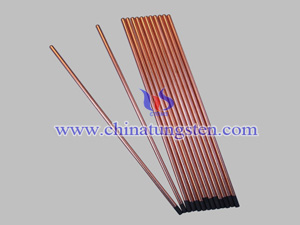Tungsten copper is a kind of psudoalloy, which is composed of W with body-centered cubic
structure (bcc) and Cu with face-centered cubic (fcc) structure and they are
immiscible or not forming intermetallic compound. It not only has high
hardness, high strength, low coefficient of thermal expansion and excellent
wear resistance and corrosion resistance of W, but also has excellent
electrical conductivity, thermal conductivity and plasticity, which can be
widely used in some electrical contact materials or electrode materials.
Generally, the basic process is: mixing → forming → infiltration, sintering → post-processing.
But
tungsten copper electrode fabricated by conventional process, regardless of
liquid-phase sintering or solid-phase sintering, the relative density of
tungsten copper products produced will lower than 98% because of the wetting
angle and the insoluble W in liquid Cu. Although the heating process and
re-pressing or re-sintering can remarkably improve this situation, the cost is
increasing and the overall efficiency is decreasing. Furthermore, in the
sintering process will happen inevitably growth of tungsten grains, which would
make it difficult to meet the performance of the market demands tungsten copper
electrode material now.
The
definition of chemical co-precipitation is that in solution mixing materials
with different chemical compositions were prepared precursor precipitate
mixture added a suitable precipitating agent, then the precipitate is dried or
calcined, to thereby obtain the corresponding powder particles. It has two
advantages, one is a nano-powder materials can be obtained directly by chemical
composition homogeneous solution in a variety of chemical reactions, and the
other is easy to prepare small particle size and distribution of nano-powder
materials.
The
experiment use ammonium tungstate, copper sulfate pentahydrate and concentrated
nitric acid as raw materials. The specific operation of concentrated nitric
acid in a copper nitrate solution was added with stirring, and then the mixed
solution was added a solution of ammonium tungstate, a magnetic stirrer in the
chemical co-precipitation reaction; After 1h the reaction solution was removed
and the precipitate was placed in a muffle furnace firing 2h, to obtain
tungsten copper composite oxide powder; after reduction by hydrogen obtained
tungsten copper composite powder; then the tungsten-copper composite powder is
extruded to form a green with a certain density and strength, ultra-fine grain
was finally sintered tungsten copper alloy products.
 Tungsten copper powder is polygon and the granularity
is between 30nm – 50nm. Cu into a network-like structure of the W particles are
bonded together in an approximation polygon and evenly distributed. This is
because the raw material for preparing tungsten-copper composite powders of
tungsten and copper salt solution, the distribution of the particles in the
solution itself more evenly in the strong magnetic stirring effect, will make
the precursor powder to retain the basic solution mixed state molecular level. And
calcination and hydrogen reduction process in low temperature effectively
inhibited the growth W grains. In addition, the initial structure of the powder
is the oxides of tungsten and copper, their mutual isolation is not conductive
to the growth of tungsten oxide particles, but is beneficial for evenly
dispersed tungsten copper composite powder. From the fracture morphology, W
grain evenly distributed in the Cu phase, forming larger dimples around, Cu phase
has continuous web-like distribution along with the W grains. From the
structure, with the increase in the sintering temperature, tissue distribution
is more uniform, the porosity is also decreased. From the properties of alloy, Tungsten-copper
composite compacts during sintering two-phase distribution, effective at
power-conduction electron-average running speed increases, the conductivity
also increases; complete copper network-like structure decrease the contact
area of coarse W grains, which is difficult to form necking and beneficial for
thermal conduction.
Tungsten copper powder is polygon and the granularity
is between 30nm – 50nm. Cu into a network-like structure of the W particles are
bonded together in an approximation polygon and evenly distributed. This is
because the raw material for preparing tungsten-copper composite powders of
tungsten and copper salt solution, the distribution of the particles in the
solution itself more evenly in the strong magnetic stirring effect, will make
the precursor powder to retain the basic solution mixed state molecular level. And
calcination and hydrogen reduction process in low temperature effectively
inhibited the growth W grains. In addition, the initial structure of the powder
is the oxides of tungsten and copper, their mutual isolation is not conductive
to the growth of tungsten oxide particles, but is beneficial for evenly
dispersed tungsten copper composite powder. From the fracture morphology, W
grain evenly distributed in the Cu phase, forming larger dimples around, Cu phase
has continuous web-like distribution along with the W grains. From the
structure, with the increase in the sintering temperature, tissue distribution
is more uniform, the porosity is also decreased. From the properties of alloy, Tungsten-copper
composite compacts during sintering two-phase distribution, effective at
power-conduction electron-average running speed increases, the conductivity
also increases; complete copper network-like structure decrease the contact
area of coarse W grains, which is difficult to form necking and beneficial for
thermal conduction.

没有评论:
发表评论